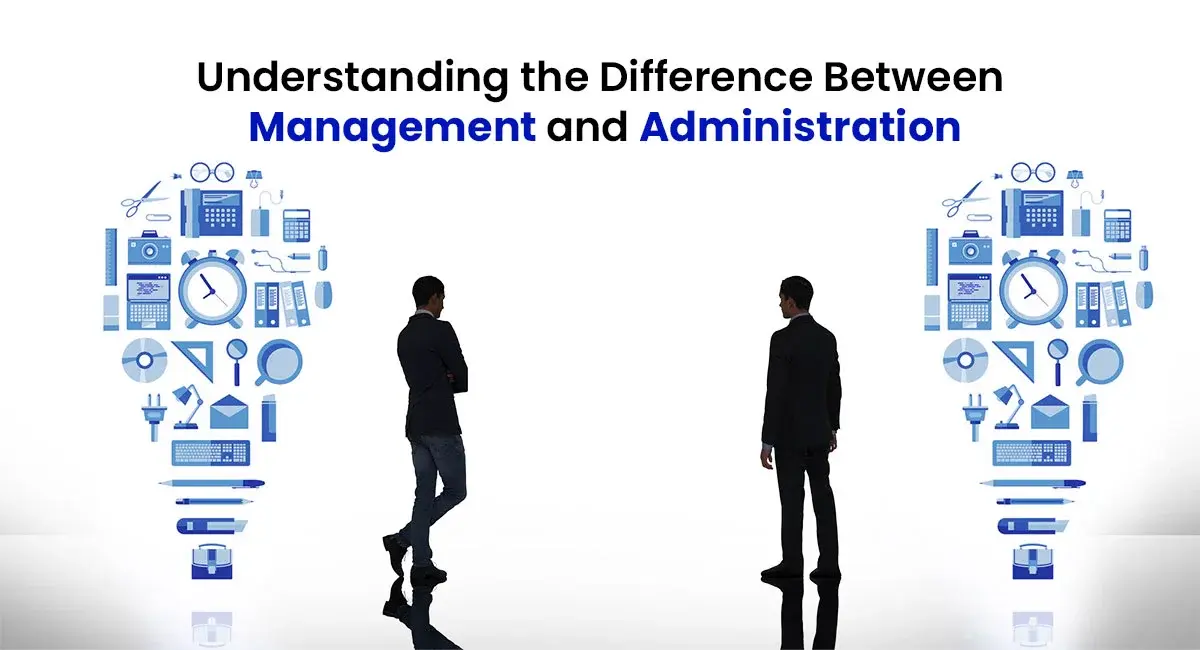Understanding the Difference Between Management and Administration In the world of business, two terms often overlap and are used interchangeably—management and administration. While they may seem similar, they serve distinct purposes within an organization. To operate efficiently and achieve desired goals, businesses must understand the management and administration differences. This blog dives deep into the difference between management and administration, providing a clear understanding of their roles, objectives, and significance in the business world. Whether you’re a professional, student, or entrepreneur that is essential for informed decision-making and effective leadership. What is Management? Management refers to the process of planning, organizing, leading, and controlling resources to achieve organizational objectives efficiently. It focuses on executing plans and ensuring day-to-day operations run smoothly. Core Functions of Management Planning: Developing strategies and determining the steps needed to meet objectives. Organizing: Allocating resources, assigning tasks, and structuring teams. Leading: Guiding and motivating employees to achieve goals. Controlling: Monitoring performance and making adjustments when necessary. Managers are responsible for turning strategies into actionable plans using efficient HR systems and overseeing their execution. Understanding the management and administration difference helps managers align their actions with organizational goals. What is Administration? Administration refers to the process of formulating policies, setting goals, and establishing the framework within which management operates. It involves decision-making at the highest level and focuses on long-term planning and strategy, leveraging a robust human resource management system. Core Functions of Administration Policy Formulation: Defining the vision, mission, and objectives of the organization. Resource Allocation: Making decisions about the distribution of resources. Strategic Oversight: Ensuring all activities align with the organization’s overarching goals. Administrators often function at the executive level, making critical decisions that shape the organization’s direction. Understanding the difference between management and administration highlights how these roles complement one another. Management and Administration: Key Differences Management focuses on the execution of policies and the achievement of short-term objectives, while administration revolves around policy-making and long-term strategic planning. Management is generally associated with middle and lower levels of an organization, whereas administration operates at the topmost level. Decision-making in management is centered on operational and tactical aspects, such as resource allocation and task delegation. In contrast, administration deals with strategic decisions like organizational goals and overall policies. This distinction underscores the management and administration difference between their roles and responsibilities. What is the Difference Between Management and Administration in Practice? In practice, the difference between management and administration becomes apparent in how organizations operate. Administrators set the overall direction, while managers implement the plans and oversee the workforce. Example: A Corporate Organization In a corporate setup: The administration is responsible for setting goals, formulating strategies, and allocating resources. Management handles the implementation of these strategies, ensuring that the tasks are completed effectively and efficiently. This practical application of roles demonstrates what is the difference between management and administration and highlights their interdependence. Importance of Understanding the Difference Recognizing the management and administration difference is vital for organizations to function smoothly and achieve their objectives. Clear Role Definition Understanding the distinction between management and administration ensures clarity in responsibilities. This prevents confusion and allows each team to focus on their specific tasks, increasing efficiency. Better Decision-Making Knowing what is the difference between management and administration enables organizations to make better decisions, as they can allocate resources and responsibilities more effectively. Enhanced Collaboration By recognizing the unique contributions of each role, organizations can foster a collaborative environment that ensures both strategic planning and operational execution are well-coordinated. Challenges in Differentiating Management and Administration Despite their distinct functions, the difference between management and administration can sometimes be blurred due to overlapping responsibilities. Common Challenges Role Overlap: In smaller organizations, the same individual may perform both management and administrative roles. Dynamic Environments: Rapid changes in industries often lead to evolving roles such as adapting to modern HRMS software to streamline operations, making it harder to differentiate between the two. Cultural Variations: In some cultures, administration encompasses management functions, while in others, they are treated as separate. These challenges make understanding what is difference between management and administration more nuanced and context-dependent. How to Balance Management and Administration Tips for Administrators Clearly define organizational policies and goals. Regularly communicate objectives to management. Monitor the implementation of policies and make necessary adjustments. Tips for Managers Operate within the framework set by administrators. Adapt to on-the-ground challenges while ensuring alignment with organizational goals. Provide feedback to administrators for better strategic planning. Balancing these roles ensures that both strategic and operational needs are met, emphasizing the management and administration difference between planning and execution. What is the Difference Between Management and Administration Across Sectors? In Education In the education sector, administration focuses on setting academic policies, budgets, and institutional goals. Management ensures these policies are implemented effectively by overseeing day-to-day activities like teaching schedules and staff management. In Healthcare Administration in healthcare defines patient care standards, allocates budgets, and ensures regulatory compliance. Management handles the daily operations of hospitals or clinics, ensuring that patients receive quality care. Such sector-specific examples highlight what is the difference between management and administration and their relevance in various industries. Future Trends in Management and Administration Integration of Technology The adoption of advanced tools like AI and data analytics is bridging the management and administration difference, enabling more seamless coordination between strategy and execution. Leadership Development Organizations are increasingly focusing on developing leadership skills that encompass both management and administrative capabilities. Understanding what is the difference between management and administration is essential for cultivating future leaders. Emphasis on Agility The future will require administrators and managers to be more agile, adapting to rapid changes in business environments while maintaining their distinct roles. Frequently Asked Questions What is the difference between management and administration? Management is primarily concerned with implementing policies and achieving short-term goals, while administration focuses on policy-making and long-term planning. How do their roles differ in an organization? Management involves day-to-day operations and tactical decisions, whereas administration handles strategic planning and resource allocation at

